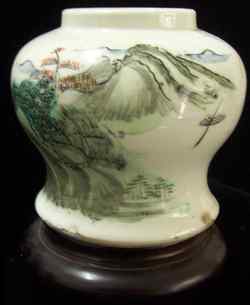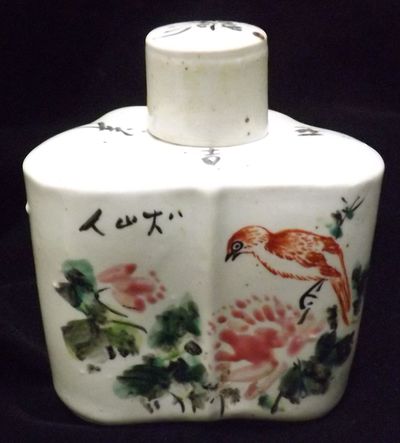Qianjiang porcelain
Qianjiang Porcelain - breathing a new life into an old tradition
Qianjiang is a porcelain decoration style that resembles classic Chinese
paintings, as they are/were painted on paper or silk. The painting
style itself is not the only thing that is very similar.
|
Like
those paintings, Qianjiang porcelain frequently have text containing
verses, poems, dedications, etc. either at the edge, or on the reverse
side of vessels. |
19th century Qianjiang jar depicting a landscape  |
Origins
The Qianjiang style developed in the middle of the 19th century. Although there are claims Qianjiang decorations existed already in the Daoguang reign (1821-1850), the earliest confirmed porcelain items in this style were made around 1850 by Cheng
Men, a porcelain painter working for the imperial kiln, and his son.
During the following Tongzhi reign little progress was made and it found limited use. It was not until the Guangxu reign (1875-1908) that this style of porcelain painting became really popular.
It was in use throughout the late Qing dynasty and the early republic.
In the 1920s it started to decline, and by 1930 most Qianjiang painters
had switched to another painting style - the New Fencai style.
Some members of the famous porcelain painter group, the Eight Friends of Zhushan are also known to have started out with Qianjiang painting, shifting later to the New Fencai style.
 Tea caddy with Qianjiang |
The main difference between Qianjiang and the original Fencai painting was the result of using a different painting material. The original Qianjiang paintingshad in less bright colors. Qianjiang porcelain used the same style as classical Chinese paintings, but instead of painting on paper or silk it was painted on top of the fired glaze of porcelain. In the early 1900s new painting materials became available.
The tea caddy on the left showas a decoration that indicates the period when Qianjiang paintings were slowly replace by New Fencai paintings. |
Qianjiang decorations appear also frequently on late 19th century porcelain plaques. Normally, they are small in size and the glaze shows a slightly rippled or wavy surface, typical for the Guangxu period. These earlier Qianjiang decorations are usually painted in pale colors. This is the result of the painting technique used, which did not allow for the strong, bright colors of Fencai porcelain.
Be careful with such items, if you should own any Qianjiang porcelain from this period, especially plaques. Due not rub the surface, if possible. Decorations of this period are easily rubbed off, which is also the reason why the accompanying handwritten text or signatures are frequently unreadable.
